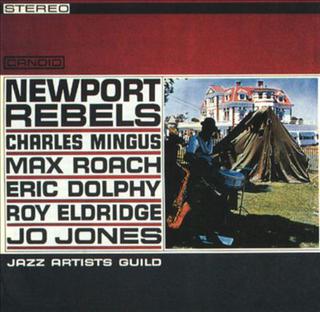Bassist Charles Mingus stood on the passenger seat of a convertible speeding through Newport, Rhode Island, shouting, “Come to my festival!” It might have looked like marketing, but make no mistake: This was a protest. It was 1960, and Mingus was challenging what he saw as the failings of the jazz scene, specifically the one created by the Newport Jazz Festival, set to be held over the next five days. He fought back by holding his own.
The Newport Rebels Festival, as it would be known, was a way to reclaim the music from the other festival’s marketers. But what was supposed to be an alternative festival turned out to be the only one in town, as concertgoers at the Newport Jazz Festival rioted, abruptly ending it. Newport in 1960 ended up being the unlikely site of a convergence of politics, art, and drunken anger.
By 1960, jazz was going through many changes, including how it was played and who its listeners were. As Roderick Graham points out in the Journal of Black Studies, “Before 1950, jazz was considered a lowbrow music.” And because it was mostly performed by Black artists, there was an effort to “deracialize” it. Record labels tried to figure out how to make money from Black music while stripping away its associations with Blackness. It worked for a while, as jazz topped the charts before the 1950s. But performers began to experiment with the form—bebop and free jazz, for example, bringing the music into an era “powered more by creativity and less by sheer album sales.”

The Newport Jazz Festival launched in 1954, and as Scott Saul writes in Freedom Is, Freedom Ain’t: Jazz and the Making of the Sixties, its aim was to shake jazz’s association with “urban nightclubs” and bring money to the city’s lagging economy. But the image Newport Jazz projected wasn’t one that sat well with some musicians. It was too pop, too white; it lacked innovation and paid its performers too little.
Mingus and fellow organizer Max Roach conceived their festival as “an anti-festival where the musicians seized the means of production,” Saul explains. Organizers slept in tents on the beach, built their own stage, and funded it by asking for audience contributions. It was a small, mostly uneventful affair. But just a few blocks away at the main festival, things were out of control, and it had very little to do with the music.
Weekly Newsletter
While the protest of the Rebel Fest was based, in part, on inequities, the Newport riots were more alcohol-fueled anger at an overbooked event. And, as Saul notes, while the police may have tried to link the riots to either jazz or to the larger context of protests, “there is little evidence to suggest that black festival goers participated in the rioting or that black musicians condoned in any way the disturbance held on their music’s behalf.” But Mingus, in his outspoken style, was an exception, saying the riots were inevitable (and maybe even earned) because the festival organizers “confused rock ’n’ roll with jazz. They lost their identity with jazz.”
At its core, the Rebels Festival was an early example of artists taking control of their art. Mingus explained it simply: “just because somebody didn’t make money hundreds of years ago because he was an artist doesn’t mean that a musician should not be able to make money today and still be an artist.”







